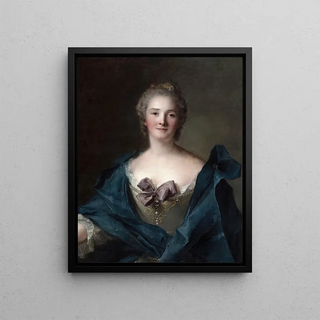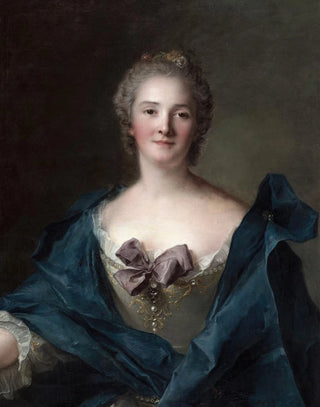Art print | Portrait of a woman - Jean-Marc Nattier


View from behind

Frame (optional)
Portrait of a Woman - Jean-Marc Nattier – Captivating Introduction
The "Portrait of a Woman" by Jean-Marc Nattier is an iconic 18th-century artwork, embodying the elegance and sophistication of its era. Nattier, renowned for his refined portraits, masterfully captures the essence of a woman whose grace and beauty transcend time. This painting, both intimate and majestic, invites viewers to immerse themselves in a universe where charm and delicacy meet. Through this portrait, the artist does not merely depict a female figure; he evokes an atmosphere charged with emotion, where every detail and color contributes to creating an unforgettable visual experience.
Style and uniqueness of the work
Nattier's style is distinguished by his ability to blend realism and idealization. In "Portrait of a Woman," he employs a palette of soft, luminous colors, enhancing the brightness of the skin and the richness of the fabrics. The delicate drapery of the dress, skillfully rendered, seems almost alive, and the woman's gaze, both mysterious and engaging, irresistibly draws the eye. The artist excels in composition, placing his subject at the center of a space that feels both intimate and open, allowing the viewer to emotionally engage with the work. The carefully orchestrated light plays a crucial role, creating subtle shadows that add depth and volume to the figure. This painting is a true ode to feminine beauty, revealing not only the external appearance of its subject but also a psychological depth that embodies the spirit of women of his time.
The artist and his influence
Jean-Marc Nattier, born in 1685, left a lasting mark on the history of French painting through his unparalleled talent in portraiture. A pupil of great masters, he developed his own style, influenced by Rococo, while incorporating elements of classicism. Nattier was able to capture the spirit of the age, becoming the court portraitist of Louis XV, creating numerous noble portraits. His innovative approach, which combines meticulous attention to detail with artistic finesse, established him as a leading figure in 18th-century portrait art.

Matte finish

View from behind

Frame (optional)
Portrait of a Woman - Jean-Marc Nattier – Captivating Introduction
The "Portrait of a Woman" by Jean-Marc Nattier is an iconic 18th-century artwork, embodying the elegance and sophistication of its era. Nattier, renowned for his refined portraits, masterfully captures the essence of a woman whose grace and beauty transcend time. This painting, both intimate and majestic, invites viewers to immerse themselves in a universe where charm and delicacy meet. Through this portrait, the artist does not merely depict a female figure; he evokes an atmosphere charged with emotion, where every detail and color contributes to creating an unforgettable visual experience.
Style and uniqueness of the work
Nattier's style is distinguished by his ability to blend realism and idealization. In "Portrait of a Woman," he employs a palette of soft, luminous colors, enhancing the brightness of the skin and the richness of the fabrics. The delicate drapery of the dress, skillfully rendered, seems almost alive, and the woman's gaze, both mysterious and engaging, irresistibly draws the eye. The artist excels in composition, placing his subject at the center of a space that feels both intimate and open, allowing the viewer to emotionally engage with the work. The carefully orchestrated light plays a crucial role, creating subtle shadows that add depth and volume to the figure. This painting is a true ode to feminine beauty, revealing not only the external appearance of its subject but also a psychological depth that embodies the spirit of women of his time.
The artist and his influence
Jean-Marc Nattier, born in 1685, left a lasting mark on the history of French painting through his unparalleled talent in portraiture. A pupil of great masters, he developed his own style, influenced by Rococo, while incorporating elements of classicism. Nattier was able to capture the spirit of the age, becoming the court portraitist of Louis XV, creating numerous noble portraits. His innovative approach, which combines meticulous attention to detail with artistic finesse, established him as a leading figure in 18th-century portrait art.






